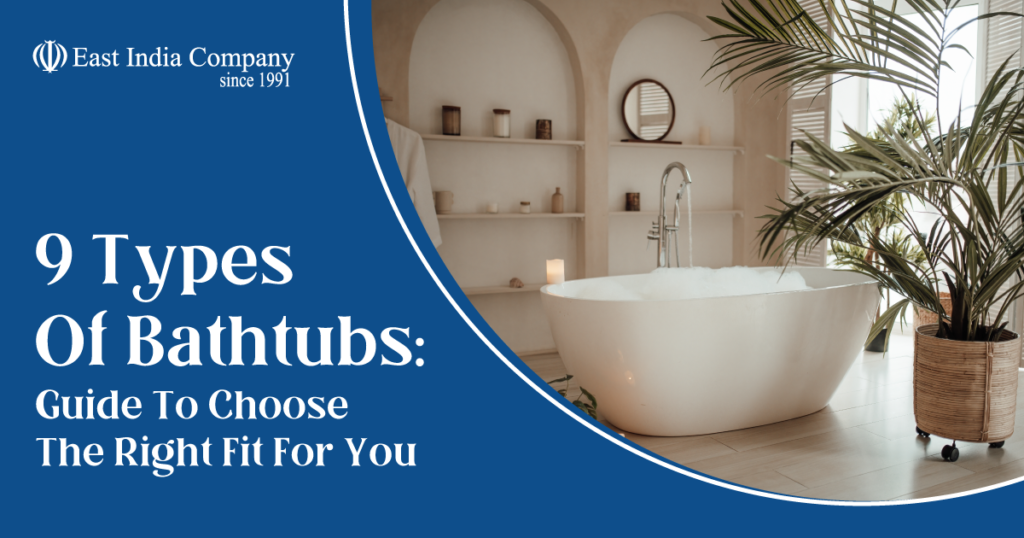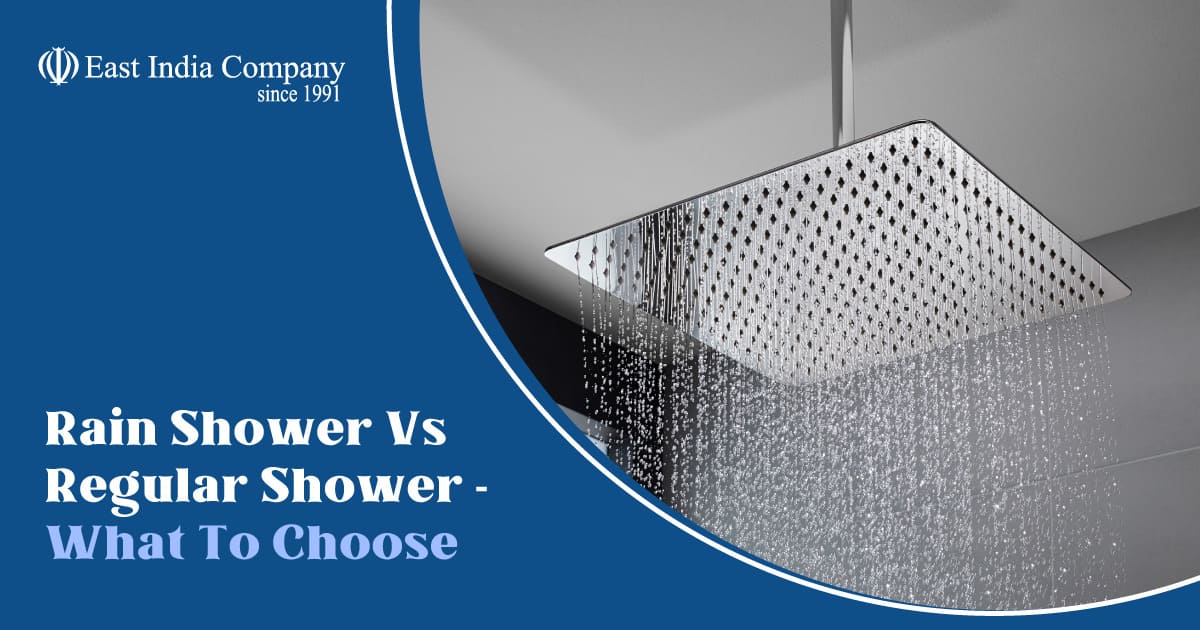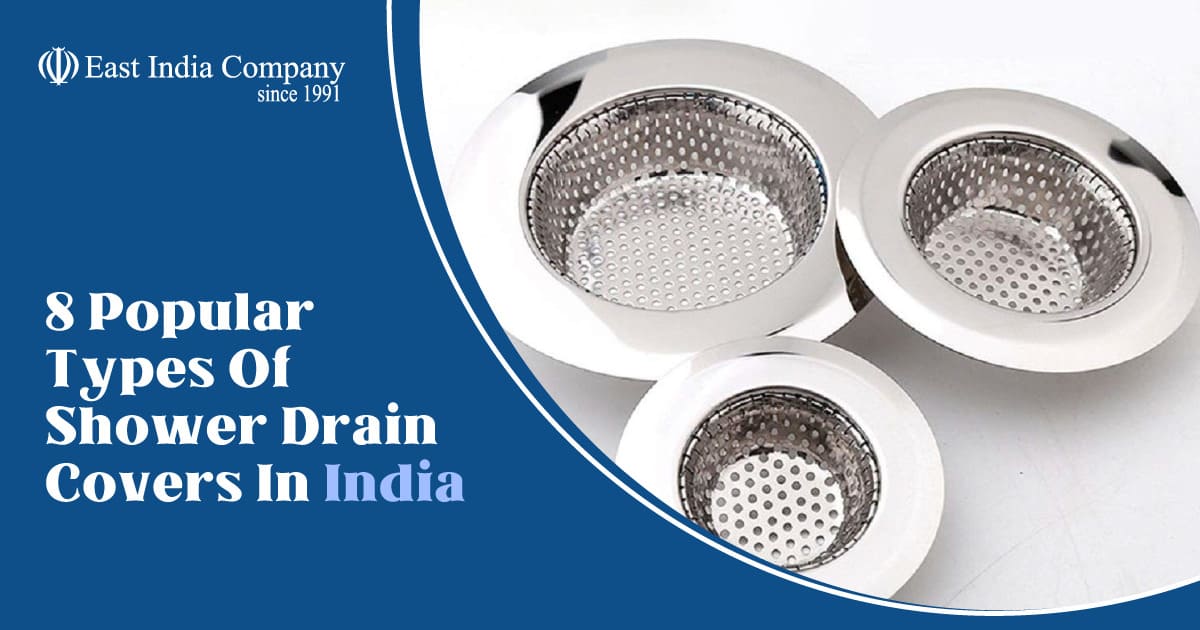Introduction
What is more rejuvenating after a stressful day than a long, relaxing soak in a warm bath? At East India Company, we have decades of expertise in helping customers find the perfect bathtubs to turn their bathrooms into soothing sanctuaries.
From classic clawfoot tubs to modern air jet models, there are many different types of bathtubs to consider before making this important investment for your home. In this comprehensive blog from our experienced staff, we will walk you through the nine most popular bathtub styles, highlighting the pros each variety has to offer.
Here are the 9 types of bathtubs to look for and purchase for your bathroom!
1. Alcove bathtubs
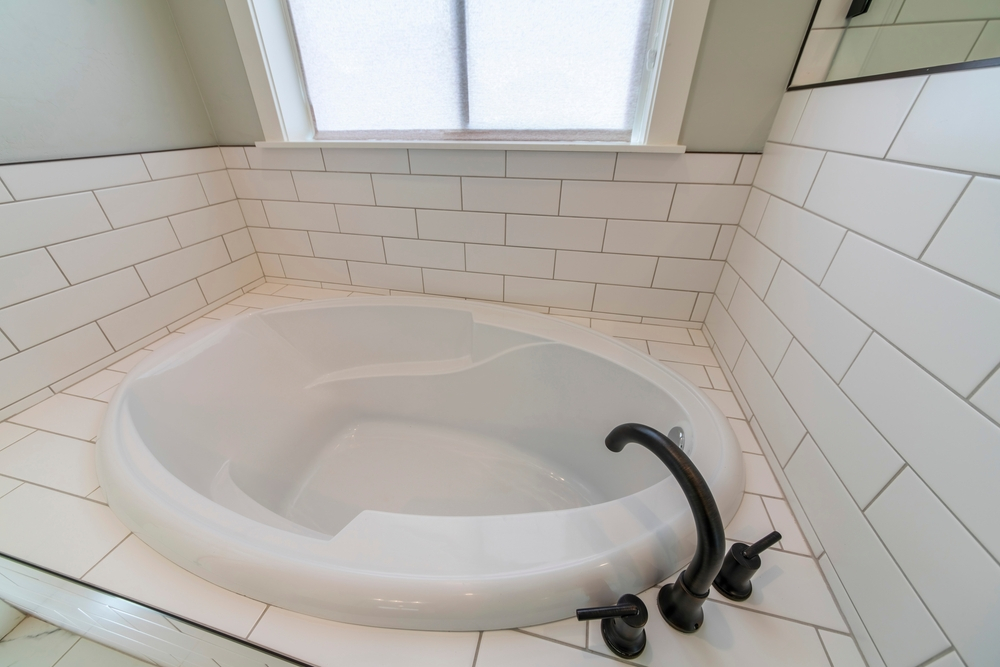
Alcove tubs are designed to fit into a small recessed area in your bathroom. With three sides enclosed by walls, they are typically longer and deeper than many other bathtubs. Their space-saving shape makes them a smart choice for small bathrooms.
Pros:
- The space-saving shape fits nicely into alcove spaces
- Often deeper than freestanding tubs
- Range of sizes to fit different spaces
2. Corner Bathtubs
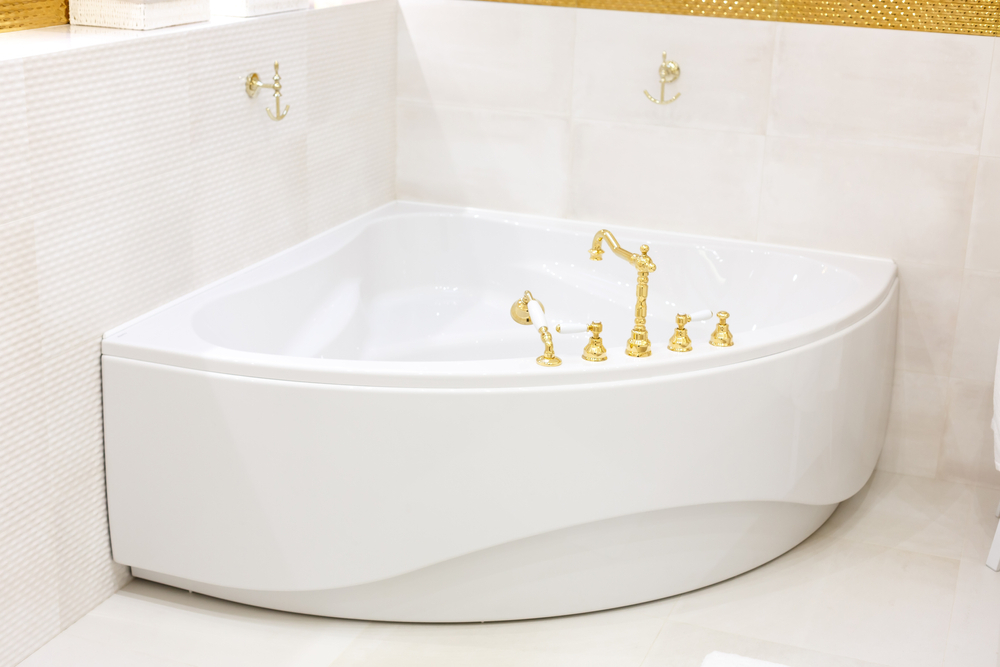
As their name implies, corner bathtubs are perfectly angled to tuck into a corner area, utilising space that might otherwise go unused. They come in many styles and sizes to blend seamlessly into your existing layout.
Pros:
- Take advantage of wasted corner space
- Distinctive look for bathroom
- Range of sizes from small to extra-large
3. Drop-In Bathtubs

Drop-in or under-mount bathtubs sit below floor level, so only the tub’s top rim is visible. This creates a sleek, modern look, giving the illusion that the tub is part of the floor. They require extensive planning and renovation but provide a contemporary, seamless style.
Pros:
- Streamlined contemporary appearance
- Easier access and entry
- Range of sizes and shapes
4. Freestanding Bathtubs

Freestanding tubs make a dramatic style statement as the centerpiece of your bathroom. These versatile tubs come in various unique shapes and materials, from stone resin to acrylic and copper. They can serve as either a soaking tub or a shower.
Pros:
- Wide range of styles and materials
- The focal point of bathroom décor
- Often quick and easy installation
5. Soaking Bathtubs
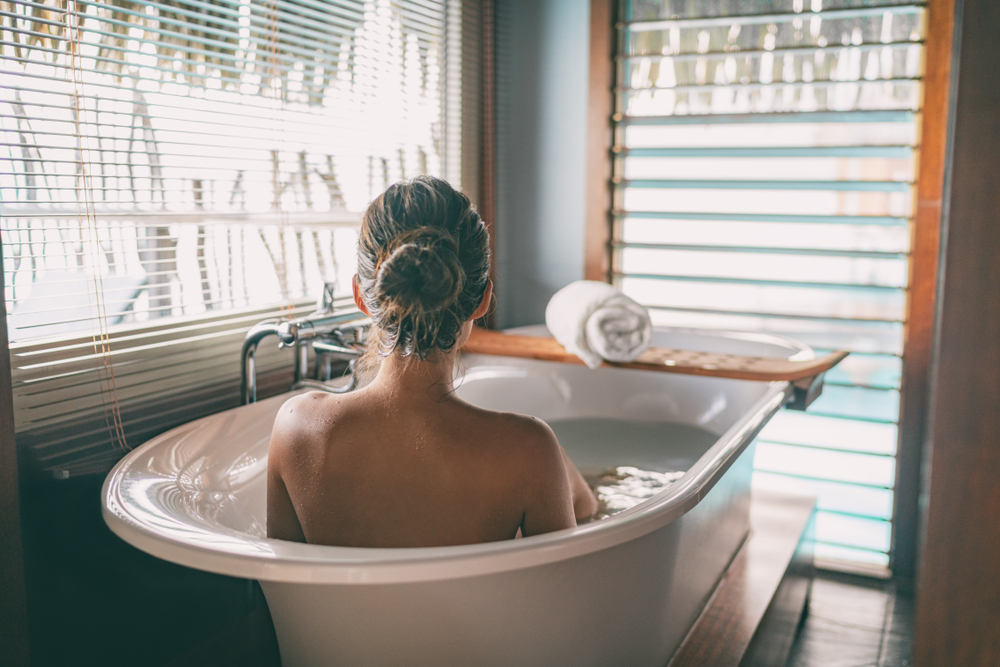
As their name suggests, soaking tubs are designed for relaxing, therapeutic long soaks. They feature ergonomic shapes to cradle your back and minimize strain on joints and muscles. These tubs are often deeper, allowing more coverage for sore, tired bodies.
Pros:
- Contoured shapes provide back support
- Deeper water coverage for soaking
- Range of sizes and depths
6. Jetted Bathtubs

Jetted tubs take relaxation to the next level by using air jets to send pulsating streams of air bubbles through the warm bathwater. This provides a spa-like massage experience right at home. Most models feature settings to adjust jet pressure and direction.
Pros:
- Provides full-body massage
- Customises water jet settings
- Luxurious home spa experience
7. Tub and shower combo
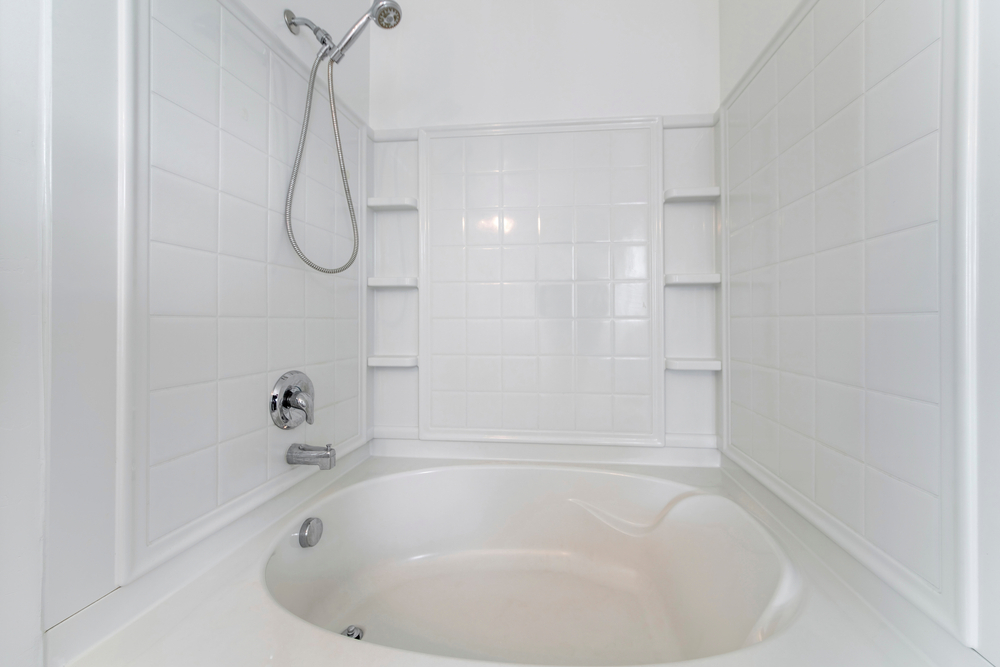
The most versatile option, tub, and shower combos, fulfill double duty, serving as both bathtub and shower stall. From basic models with shower curtains to customized designs with glass doors, they maximise functionality in one compact space.
Pros:
- Dual purpose provides flexibility
- Space-saving all-in-one design
- Many style and size configurations
8. Walk-In Bathtubs
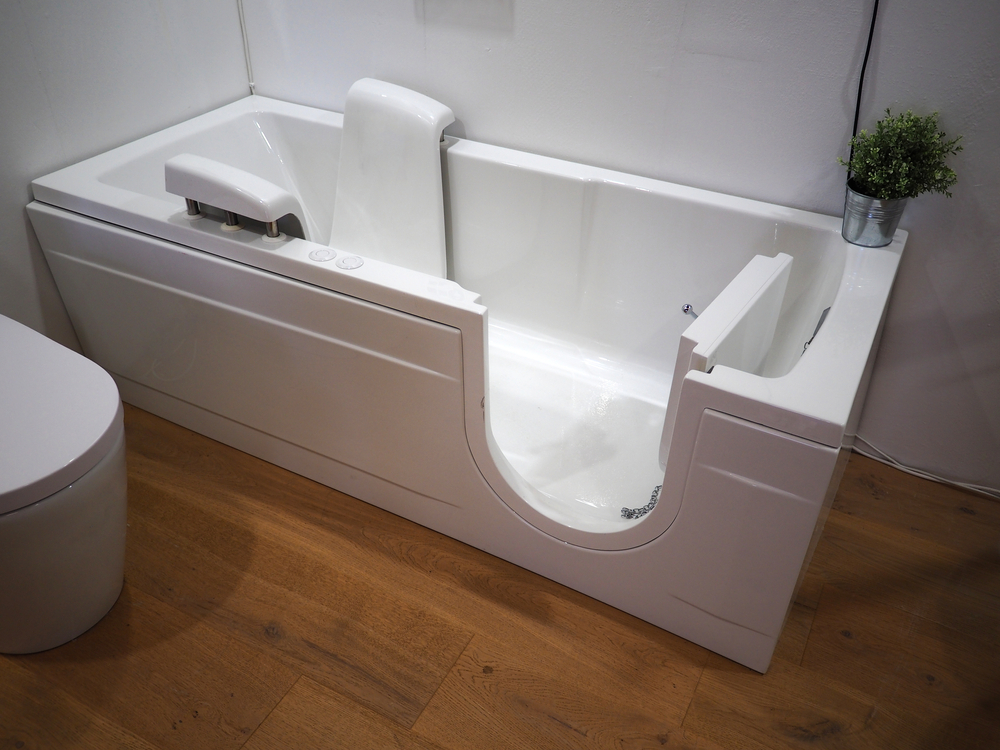
Walk-in tubs are ideal for users with mobility challenges or who want easier, safer access. Their door allows you to simply step into the tub rather than climbing over the high walls of standard models. They also feature built-in seats and grab bars.
Pros:
- The door provides safe, easy entry and exit
- Includes safety features like grab bars
- Range of sizes with different door configurations
9. Sunken Bathtubs

For a luxurious spa bathroom, consider installing an elegant sunken tub. These are set partially or fully into the floor, creating the effect of an in-ground hot tub. Steps lead into the recessed tub lined with sparkling tiles or natural stone.
Pros:
- Built-in “wow” factor focal point
- Spa-like in-ground experience
- Range of sizes and depths
Factors to consider before choosing the right bathtub for you!
With so many varieties to select from, consider the following factors when choosing your ideal bathtub:
- Space and Size: Consider your available bathroom dimensions and layout to select a tub that will fit comfortably. Measure alcoves or corners to find models suited to unusual spaces.
- Features: Determine must-have features like jets, easy-access doors, or safety handles based on your needs and priorities. This will help narrow options.
- Style: Choose a style aligned with your desired bathroom aesthetic, from ultra-contemporary sunken tubs to ornamental clawfoot models. Visualize how the tub will coordinate with existing or planned décor.
- Budget: Prices can range widely depending on the complexity of installation, features, size, and materials. Have a budget in mind before you begin shopping to streamline options.
Materials to take into consideration for bathtubs!
The material your bathtub is constructed from impacts both aesthetics and functionality. Consider the pros and cons of each before deciding.
Cast Iron: Cast iron tubs are extremely durable and effective at retaining heat for longer, warmer soaks. However, they are very heavy, making installation challenging, and have limited style varieties.
Acrylic: Acrylic is lightweight, easy to clean, and available in nearly endless colors and configurations to match any décor. It scratches more easily than other materials.
Steel Enameled with Porcelain: The enamel coating on steel tubs is durable and scratch-resistant. Although limited sizes are available, these tubs also provide an elegant, vintage look.
Stone Resin: For natural aesthetics with modern durability, stone resin bathtubs infuse crushed stone into resin for an ultra-strong, stone-like finish. This material offers extensive options.
Measurement Tips & Standard Bathtub Sizes!
Be sure to measure your bathroom carefully to ensure any tub you select will properly fit. Know the standard dimensions of key tub types:
- Alcove: 30-32 inches wide x 60 inches long
- Corner: Ranges from small (48 inches) to large (up to 72 inches)
- Drop-in: Varies greatly but around 60 x 42 inches
- Freestanding: 54-66 inches long (oval) up to 71 inches (round)
- Soaking: 60-65 inches long x 30-35 inches wide
- Walk-in: Outward opening 32-37 inches (inward opening up to 60 inches)
For a personalised consultation on finding your perfect soaking tub from our wide selection, visit us at any East India Company showroom. Our design experts will help assess your space, needs, and style to recommend options tailored specifically for you.
Conclusion
After understanding the most popular types of bathtubs available along with their unique pros, deciding on the ideal model for your bathroom and needs is much more manageable.
Keep in mind key factors like dimensions, features, accessibility, installation, and visual appeal as you evaluate choices. Setting a budget ahead of time and measuring your bathroom precisely will also streamline the process.
Visit East India Company for your bathtub purchase!
East India Company is a leading retailer of premium sanitaryware products based in Chennai. We have been helping homeowners decorate their bathrooms with a wide selection of world-class bathtubs, showers, faucets, accessories, and more.
Our expert team can guide you on the latest design trends and the best products from different brands to suit your budget and space.
Visit our store to experience premium bathroom solutions all under one roof!
FAQs
1). What is the most common type of bathtub?
The most common type of bathtub is a freestanding tub, as they are versatile, come in various styles and materials, and provide an easy installation.
2). Which is the best bathtub material?
The best material for a bathtub depends on your needs, but acrylic is a popular choice as it is lightweight, easy to clean, and available in many colors and shapes.
3). How can I choose a bathtub for my bathroom?
To choose a bathtub, consider the size and layout of your bathroom, your requirements, budget, and aesthetic preferences. Measuring the space carefully will help narrow down suitable options.
4). What is a good size bathtub?
A standard size for most bathrooms is 60×30 inches. However, larger bathtubs around 60×32 or 66×32 inches provide more room for soaking.
5). Which brand is best for bathtubs?
Some top brands for high-quality bathtubs include Kohler, Jaquar, American Standard, Jacuzzi, Aquatica, and Duravit, which offer durable products with various styles, features, and installation types

